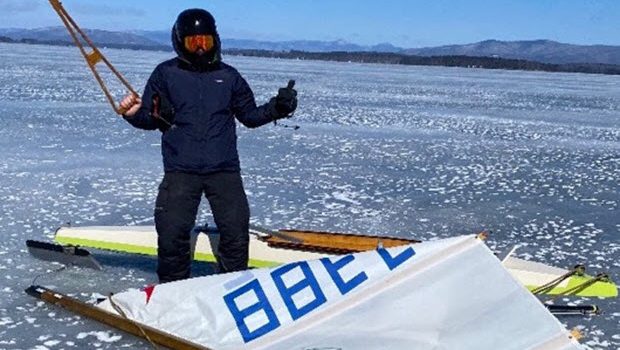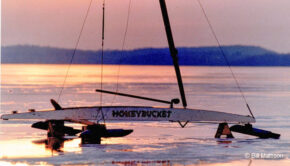Iceboating: To go or not to go
Published on March 19th, 2021
As a young sailmaker in the Midwest, having just relocated from California, the future editor of Scuttlebutt Sailing News got an early iceboating lesson when tasked to repair a ripped DN sail with blood from the sailor who flew through it.
This “I’m not in Kansas anymore” moment comes to mind when discussing iceboat safety. In this report by Jay Whitehair, Vice Commodore of the New England Ice Yacht Association, he ponders that question, to go or not to go:
In the world of ice boating we are often faced with the decision ‘to go, or not to go”. If one were to simply look out their breakfast room window and make the call for the day, I think nobody would ever make it to the ice. So by nature most of us just kit up and run with the thought ‘maybe this will work out somehow?’, and more often than not we have great days of sailing.
But what about those marginal decisions you have to make AFTER you arrive on site? Thin ice? Too much wind? Skills of others we are sailing with? If EVERYBODY else is going then why not me? These seemingly simple decisions can have dire consequences. Here is how I go about making those decisions when it comes to my extreme sporting adventures:
• Conditions: Using your personal experiences what are YOU seeing exactly? Take the time to look at all the signs you can i.e.. wind types, variable ice thickness, ice surfaces, cracks, open leads, holes, bob houses, tip ups, personal fitness, fatigue etc. From there I seek out a few of my more experienced mentors to gather what is on THEIR minds at that moment and to see what things I have overlooked.
Generally I pick up a lot of local details and items of heightened concern. Chances are somebody on scene has been playing there for days and has all the insider info – like the stuff that could hurt you. This is where taking the time to arrive early pays off.
Take all of these details and multiply them together with the end thought being: can I handle all of these concerns if thrown at me at once? Be honest with yourself and consider the simplicity of deciding “maybe I’ll sit this one out”.
• Mates: Exactly who will be out there with you? As a group (big or small), if things go bad do you have a balance of skills to un-jam a crisis? Are you able to trust/work with everybody in the pod? Are you truly independent as a group and do you have the resources to self extricate if need be? Do you have the hardware to approach the day safely or summon help if required? Does everyone have the capacity to evaluate their own skills needed to participate?
If you have less experienced participants in your group who insist on ‘giving it a go’ do you have the experience to cover their needs? These items may seem trivial in the pits, but if you land in a hostile environment they become essential elements. If the feeling persists that you are in over your head…. well, you just might be. Consider again to take a rain check.
• Overall plan: Who is the key person who knows of your sporting plans today should something go terribly wrong? If your group succumbs to a catastrophic event, what is the fallback plan? Make sure you have somebody keeping an eye on you. Someone that is not only reliable, but currently in communication and timely in character and able to initiate a rescue group if events run foul.
• Is your kit up to the task: When was the last time you had your gear apart for inspection? Are you confident it will be able to handle the conditions including an extra margin for safety? Normal wear and tear only accumulates.
The off season is a great time to tear into your entire kit – I assure you, it is not as pristine as you last remember – the damage incurred from heavy weather on your boats hardware can be shocking. A simple repair at home beats one in the field any day!
And lastly, Is your clothing sufficient for a wet walk home in the worst conditions you might face? Evaluate everything, fix what you can early, and have spares on hand when possible.
• Conclusion: Of course there are many more considerations to be made before any extreme adventures are undertaken but these are a few basic thoughts I try to entertain prior to stepping into a harness or on any boat. There is a common saying in my mountain flying circle which states, “it’s better to be on the ground wishing you were in the air, than in the air wishing you were on the ground”.
When you find yourself too deep in the breeze it can be a terrifying experience. Understand that the decision to go, or not to go, is ultimately yours to make. Trust your gut feeling and keep in mind that by sailing with good mates, dependable gear, and a solid plan, then, when you find yourself over your abilities a 180° turn is all that’s needed to return home safely.
Stay tuned for Part 2 – “6 miles under bare poles – arriving back home after a great day on the ice?!”
Above photo: Broken tiller in hand… split mast, wood chips and a sore knee… Ebben Whitehair is still thumbs up after a hard tumble.








 We’ll keep your information safe.
We’ll keep your information safe.